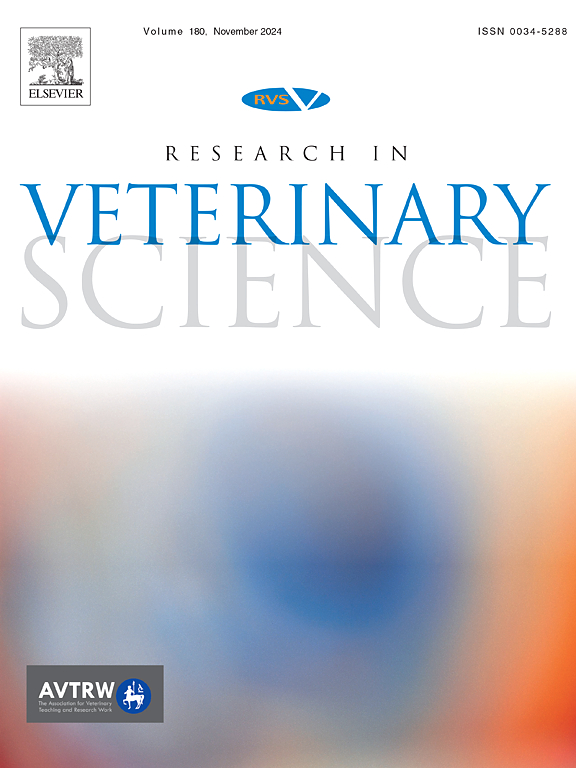驴子宫内膜:常驻免疫细胞的特征。
IF 2.2
3区 农林科学
Q1 VETERINARY SCIENCES
引用次数: 0
摘要
米兰达驴是一种濒临灭绝的驴品种。驴生殖道免疫系统的动态对管理这些动物的繁殖力对物种的改善和生存至关重要。在母马中,大量免疫细胞浸润子宫内膜促进子宫内膜异位症,这一点在母马中仍有待证实。采用Kenney和Doig分级法对32只母马进行子宫活检。苏木精-伊红染色检测中性粒细胞和嗜酸性粒细胞的浸润和分布。免疫组化检测子宫内膜巨噬细胞及B、T淋巴细胞分布。子宫内膜细胞以T淋巴细胞为主,其次为巨噬细胞。浅表上皮和腺上皮均可见T淋巴细胞。嗜酸性粒细胞、中性粒细胞和B淋巴细胞是最不常见的细胞。不同子宫内膜异位症等级(IIA, IIB和III)的炎症浸润没有差异。本研究绘制了珍妮子宫内膜的免疫细胞图谱,为该物种进一步的免疫学和生殖研究提供了有价值的核心信息。研究还强调了雌马和母马在发情和退情期间子宫内膜免疫细胞分布的显著差异,支持需要开发一种比目前的Kenney和Doig分类更合适的评分系统来评估雌马子宫内膜的形态和临床特征。本文章由计算机程序翻译,如有差异,请以英文原文为准。
Donkey endometrium: Characterization of resident immune cells
The Burro de Miranda is an endangered donkey breed. The dynamics of the immune system of the donkey's reproductive tract are essential to manage the fertility of these animals for the improvement and survival of the species. In mares, high numbers of immune cells infiltrating the endometrium promote endometrosis, which is still to be confirmed in jennies. Uterine biopsies of 32 jennies were evaluated based on the Kenney and Doig grading system used in mares. Hematoxylin and eosin stain was used to assess the infiltration and distribution of neutrophils and eosinophils. Macrophage and B and T lymphocytes endometrial distribution was conducted through immunohistochemistry.
T lymphocytes were the most predominant cells in jenny endometrium, macrophages being the second. T lymphocytes were also found in the superficial and glandular epithelium. Eosinophils, neutrophils and B lymphocytes were the least common cells. No differences were found in the inflammatory infiltrate compared to the different endometrosis grades (IIA, IIB and III).
This study mapped the immune cells in jenny's endometrium, providing core valuable information for additional immunological and reproductive studies in this species. It also highlighted significant differences in endometrial immune cell distribution between the jenny and the mare during estrus and diestrus, supporting the need to develop of a more suitable scoring system than the current Kenney and Doig categorization to assess the morphology and clinical feature of jenny's endometrium.
求助全文
通过发布文献求助,成功后即可免费获取论文全文。
去求助
来源期刊

Research in veterinary science
农林科学-兽医学
CiteScore
4.40
自引率
4.20%
发文量
312
审稿时长
75 days
期刊介绍:
Research in Veterinary Science is an International multi-disciplinary journal publishing original articles, reviews and short communications of a high scientific and ethical standard in all aspects of veterinary and biomedical research.
The primary aim of the journal is to inform veterinary and biomedical scientists of significant advances in veterinary and related research through prompt publication and dissemination. Secondly, the journal aims to provide a general multi-disciplinary forum for discussion and debate of news and issues concerning veterinary science. Thirdly, to promote the dissemination of knowledge to a broader range of professions, globally.
High quality papers on all species of animals are considered, particularly those considered to be of high scientific importance and originality, and with interdisciplinary interest. The journal encourages papers providing results that have clear implications for understanding disease pathogenesis and for the development of control measures or treatments, as well as those dealing with a comparative biomedical approach, which represents a substantial improvement to animal and human health.
Studies without a robust scientific hypothesis or that are preliminary, or of weak originality, as well as negative results, are not appropriate for the journal. Furthermore, observational approaches, case studies or field reports lacking an advancement in general knowledge do not fall within the scope of the journal.
 求助内容:
求助内容: 应助结果提醒方式:
应助结果提醒方式:


